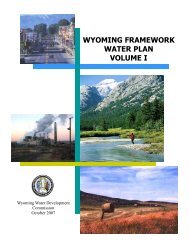Humpback chub (Gila cypha) - Upper Colorado River Endangered ...
Humpback chub (Gila cypha) - Upper Colorado River Endangered ...
Humpback chub (Gila cypha) - Upper Colorado River Endangered ...
You also want an ePaper? Increase the reach of your titles
YUMPU automatically turns print PDFs into web optimized ePapers that Google loves.
Canyon that would allow for range expansion of humpback <strong>chub</strong> should be<br />
determined.<br />
Status of Criterion 3. Criterion 3 has been met. A risk assessment and scoping<br />
environmental assessment for a temperature control device on the penstocks at<br />
Glen Canyon Dam have been completed (U.S. Bureau of Reclamation 2004).<br />
Factor B—Protection from overutilization for commercial, recreational, scientific, or<br />
educational purposes.<br />
Overutilization of humpback <strong>chub</strong> for commercial, recreational, scientific, or educational<br />
purposes is not currently considered a threat to the species. <strong>Humpback</strong> <strong>chub</strong> have no commercial<br />
or recreational value and are not sought by commercial fishermen or anglers. Collection of<br />
humpback <strong>chub</strong> for scientific or educational purposes is regulated by the Service under the Act.<br />
Criterion 4.<br />
Overutilization of humpback <strong>chub</strong> for commercial, recreational, scientific or<br />
educational purposes should be reevaluated and, if necessary, actions identified to<br />
ensure adequate protection.<br />
Status of Criterion 4. Criterion 4 has been met. No commercial, recreational<br />
or educational activities exist. Scientifically, reduced survival of adult humpback<br />
<strong>chub</strong> as a result of handling has not been proven, and delayed mortality due to<br />
sampling has not been demonstrated. Hunt (2008) concluded trammel netting as<br />
a sampling technique should be avoided at temperatures at or above 20ºC. The<br />
effects appeared much worse for hatchery-produced razorback sucker and<br />
bonytail than for wild roundtail <strong>chub</strong>. It’s assumed that wild humpback <strong>chub</strong><br />
would be similar to wild roundtail <strong>chub</strong>.<br />
Factor C—Adequate protection from diseases and predation.<br />
Meretsky et al. (2000) hypothesized that an observed decline in condition of adult humpback<br />
<strong>chub</strong> in Grand Canyon was a result of recent infestation by the internal Asian tapeworm<br />
(Bothriocephalus acheilognathi).<br />
Criterion 5.<br />
An Asian tapeworm control program should be developed and implemented in the<br />
Little <strong>Colorado</strong> <strong>River</strong> to identify levels of control that will minimize the negative<br />
effects of parasitism on the humpback <strong>chub</strong> population.<br />
Status of Criterion 5. Recovery Factor Criterion 5 has been met. Ward (2007)<br />
developed protocols for treating humpback <strong>chub</strong> for Asian tapeworm. Arizona<br />
Game and Fish Department is implementing those protocols (Clark et al. 2008).<br />
The threat of predation by nonnative fishes on humpback <strong>chub</strong> has been<br />
recognized in Grand Canyon population. Brown trout (Salmo trutta), channel<br />
catfish, black bullhead, and rainbow trout (Oncorhynchus mykiss) have been<br />
identified as principal predators of juvenile humpback <strong>chub</strong>, with estimates that<br />
16
















